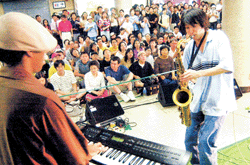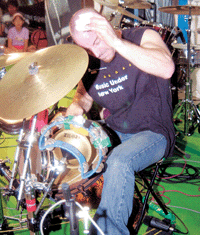|
Shakerleg makes his living banging on the drums in the echoing hollows of New York City's subway system. The platform is his stage, the clack of the No. 6 train, his muse. Built like a boxer with hands to match, he's loud enough to anger cops and the hearing-impaired. Yet he fights to be heard amongst the grim-faced thousands shuffling past him everyday.
 |
|
Crowds in Seoul actually sit down to enjoy the performances. Musicians say New Yorkers are much harder to please.
|
A masochistic love of performance, not desperation, is what drives Shakerleg, 28, and hundreds of other musicians that peddle their talents in New York's underbelly. But earlier this month, he and a handful of other subterraneans rode past their usual stops at Union Square or Penn Station and opted instead for Gangnam and Eujiro 1-ga.
Given an unaccustomed royal treatment, Shakerleg, along with a handful of mainstays of the subway circuit, was flown over to Korea to perform in various subway stops and hotels in Seoul, promoting both local tourism and the underground culture of their native city.
The term 'underground' says more about these musicians than where they play. There is so much diversity of sounds in the subways that it is hard to categorize the music, 'underground,' as such. They play anything from folk, to reggae, to free-style hip-hop, to country-western. They are not necessarily at the margins of society, but they certainly aren't the yardstick of cultural norms. Many of these performers are some of the most gifted, if not refined, artists in the hyperactive vibrancy that makes up New York City's music scene. And whatever kind of music they play, the way that they play it is dictated by their choice of venue - it takes a lot more than just practice to play in Grand Central Station during rush hour.
"I love their music and I know Korean people," said H.K. Chung, the head of Under New York, an artist collective of native Koreans who promote urban cultural exchange between here and cities in the United States. With the financial backing of the Amigo Hotel in Seoul, Chung handpicked these talents guided by her 20-year knowledge from riding the subways. "But it has been a shock to me, this kind of positive, public response."
Apart from the sad tinkle coming from a blind man's boombox, music remains largely absent from the Seoul subways. Condemned by both law and society, musicians here can't just set up shop like they do in New York, where the activity was officially legalized during the 1980s. Seoul subway officials conduct auditions and permits for their popular Subway Theaters, but Chung feels that's against the spirit of everything that these performers from New York are about.
 |
| Drummer Shakerleg's knuckle-breaking performance is tougher than it looks. |
So Chung and Under New York took on this project to inject a much-needed shot of spontaneity into everyday Korean surroundings: "When Koreans think of performances, they think of famous musicians and high-end acts. And many talented and great musicians here won't think about doing this. Both musicians and audiences judge it poorly."
The average New Yorker probably doesn't think too highly of their own subway performers either, if they bother to notice them at all. Even hard earned attention doesn't pay the rent and put food on the table, and the method to making a living, says Shakerleg, is "penny by penny, dollar by dollar."
"I try to get by making at least $50 a day," he says. "I really don't need that much money because I don't do anything that's real expensive to entertain myself. I go to clubs and I see people just standing around and I'm like, gee, I could just go to the subway and have a party. It's a party every time I go to work."
He usually wakes up around 3pm, checks his email, and from his apartment on 139th Street in Manhattan, he hops on a train heading downtown a little after the evening rushing hour.
"Whenever I need quick cash, I go to Times Square. It's loud and crowded and it's miserable to play there but the tourists just throw money at you."
But he uses hushed tones talking about his favorite place to play. "Bar none, the L line at Union Station. Nothing compares to the acoustics in there. The sound is amazing," he says, a sentiment reverentially echoed by others.
Then there are everyday hazards that accompany this line of work. Encounters with hoodlums, crazies and cops are about as frequent and predictable as the rush-hour traffic. Once a softy, two years underground has hardened Shakerleg. He used to just let it go when smart-aleck teens would heckle him and play rough tag with his drum set. But he says he now goes "absolutely buck wild" if a kid does so much as graze his cymbals as he's passing by. "Can't touch it unless you play like me," he warns.
But subway musicians come to play there because, and not in spite of, these obstacles. It is the world's most demanding stage, Shakerleg says, but it can also be its most forgiving. You can find comfort in its harsh indifference and realize you have very little to loose if you try to do something different or new. You find your source of strength as an artist, he says, from what's inside and not from what's around you.
Seeing another subway performer, a guitarist named Martin Sexton, is what first drew him into the subway life: "He pushes himself to the limit and plays with total honesty every time. Music should be overwhelming. No matter where you're playing, it can't be just background music."
Shakerleg himself is considered something of an upstart in the subway scene. With technique and equipment all his own, he devised a clever way of making his bare hands and a jumble of garage-sale throwaways sound like a full-size drum set, often exceeding the 85 decibel limit set by subway authorities. He glued and welded together four cymbals and an inverted toy drum and commands this contraption by straddling a bongo drum that makes the rickety frame rattle and hum like a real snare. A blue tambourine, ducked tape to the side, adds ornamental flare.
His technique is inspired by equal amounts of pain and ingenuity. While drumming is a mostly top-down exercise, his playing is punctuated by violent upward snaps of the wrist, hitting the cymbals with his bare knuckles from underneath instead of from above. It's a timing issue, says Shakerleg, so he doesn't have to reload hitting the cymbals from the top when he's mostly preoccupied below banging away at the bongo. He came up with this idea while driving - the top of his fingers kept hitting the steering wheel when he was drumming both hands against his knees.
Percussion aficionados caught whiff: "People have heard about me and take pictures of me and stuff. I better make a CD before someone copies my gimmick and starts doing it better than I can." But with hand bandaged and swollen like a prizefighter, he says that no one sticks with it for too long because of the pain.
Though Shakerleg displays a shaman's intensity of any serious drummer, he sees this as a means to an end. Like many other street and subway performers, waiters, porters and just about anyone else who makes the city run, his real passion lies in acting. He hopes to get enough exposure and recognition so that one day, someone can picture how his manic energy on the platforms can translate onto the acting stage.
By Warren Lee 2003.09.20
|